| Bavarian B V | |||||||||||||||||||||||||||||||||
|---|---|---|---|---|---|---|---|---|---|---|---|---|---|---|---|---|---|---|---|---|---|---|---|---|---|---|---|---|---|---|---|---|---|
| |||||||||||||||||||||||||||||||||
| |||||||||||||||||||||||||||||||||
| |||||||||||||||||||||||||||||||||
The Bavarian Class B V steam locomotives were operated by the Bavarian Eastern Railway (Bayerische Ostbahn) in Germany.
They had an external frame with outer valve gear and a Belpaire boiler.
They were equipped with 2 T 8 tenders.
| Bavarian B V | |||||||||||||||||||||||||||||||||
|---|---|---|---|---|---|---|---|---|---|---|---|---|---|---|---|---|---|---|---|---|---|---|---|---|---|---|---|---|---|---|---|---|---|
| |||||||||||||||||||||||||||||||||
| |||||||||||||||||||||||||||||||||
| |||||||||||||||||||||||||||||||||
The Bavarian Class B V steam locomotives were operated by the Bavarian Eastern Railway (Bayerische Ostbahn) in Germany.
They had an external frame with outer valve gear and a Belpaire boiler.
They were equipped with 2 T 8 tenders.
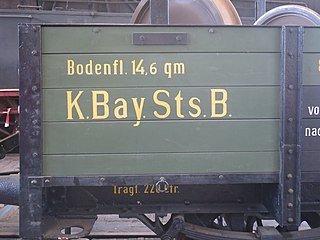
The Royal Bavarian State Railways was the state railway company for the Kingdom of Bavaria. It was founded in 1844. The organisation grew into the second largest of the German state railways with a railway network of 8,526 kilometres by the end of the First World War.
The Royal Bavarian Eastern Railway Company or Bavarian Ostbahn was founded in 1856. Within just two decades it built an extensive railway network in the eastern Bavarian provinces of Upper Palatinate (Oberpfalz) and Lower Bavaria (Niederbayern) that had previously been largely undisturbed by the railway. Much of this network is still important for local and long distance rail traffic operated by the Deutsche Bahn today.

The Bavarian Class D XI engines were branch line (Lokalbahn) saturated steam locomotives built for service with the Royal Bavarian State Railways.
The steam engines of Class G 4/5 H operated by the Royal Bavarian State Railways were the most powerful of the German, 2-8-0, freight locomotives.

The Bavarian B V steam engines were early German 2-4-0 locomotives of the Royal Bavarian State Railways.
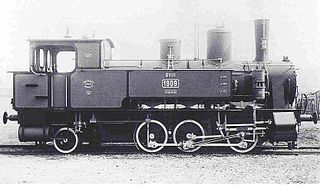
The Bavarian Class D VIII were saturated steam locomotives with the Royal Bavarian State Railways.
The Bavarian Class PtzL 3/4 engines with the Royal Bavarian State Railways were rack railway locomotives whose cogwheel drive was designed for working on tracks with a Strub rack. In 1923 they were incorporated by the Deutsche Reichsbahn as DRG Class 97.1 in their numbering plan. The locomotives remained on their regular route between Erlau and Wegscheid until the closure of this rack railway in 1963. The last journey was on 5 January 1963. They were scrapped in April 1964 at Simbach am Inn.

The Bavarian Class GtL 4/4 engines were superheated steam locomotives in service with the Royal Bavarian State Railways for duties on branch lines (Lokalbahnen).

The Bavarian Class D XII steam locomotives were manufactured by the firm of Krauss from 1897 for the Royal Bavarian State Railways. Ninety six of them were procured for service on the stub lines running from Munich into the mountains, but in reality they were stationed in many large Bavarian locomotive depots. Two engines were transferred to the Palatinate Railway (Pfalzbahn) in 1916, the remaining 94 later joined the Deutsche Reichsbahn fleet and were incorporated as DRG Class 73.0-1 with operating numbers 73 031–124.
The Class D III engines of the Royal Bavarian State Railways were tank locomotives designed for shunting and Vizinalbahn service.

The goods train locomotives of Class C VI were German steam engines built between 1899 and 1905 for the Royal Bavarian State Railways. It had great similarity to the Prussian G 5.4, but had a higher boiler overpressure and better riding qualities. In all the Bavarian state railways procured 83 engines of this type over that period. More machines with slight modifications were acquired between 1907 and 1909. These 37 engines were given the designation G 3/4 N. The Deutsche Reichsbahn inherited 64 Class C VI and 32 Class G 3/4 N engines. These were given operating numbers 54 1301–1364 and 54 1401–1432. The Class C VII locomotives remained in service until 1931, their Class G 3/4 N sister locomotives until 1935.
The Bavarian C III engines were steam locomotives of the Royal Bavarian State Railways.
The Bavarian B VII was an experimental locomotive with the Royal Bavarian State Railways.
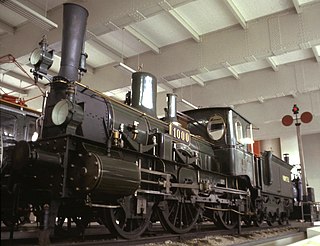
The B IXs of the Royal Bavarian State Railways, built from 1874, were the first express train locomotives in Bavaria.
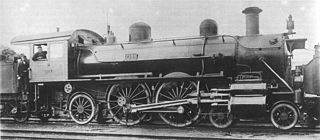
The Class S 2/5 locomotives operated by the Royal Bavarian State Railways included two express train, steam locomotives of American origin which were fitted with Vauclain compound engines.
The Bavarian Class E I steam locomotives operated by the Royal Bavarian State Railways encompassed four different variants of saturated steam, goods train locomotive with a 2-8-0 wheel arrangement.
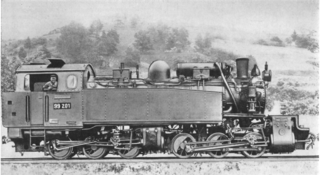
The Bavarian Class Gts 2x3/3 was a former narrow gauge, German Army, military railway, steam locomotive that was in service on the narrow gauge line from Eichstätt to Kinding.
The first four steam locomotives designated as Class B IX by the Royal Bavarian State Railways were procured from the locomotive works of Strousberg. They were transferred in 1872 to the Imperial Railways in Alsace-Lorraine. For the remainder, see Bavarian B IX.